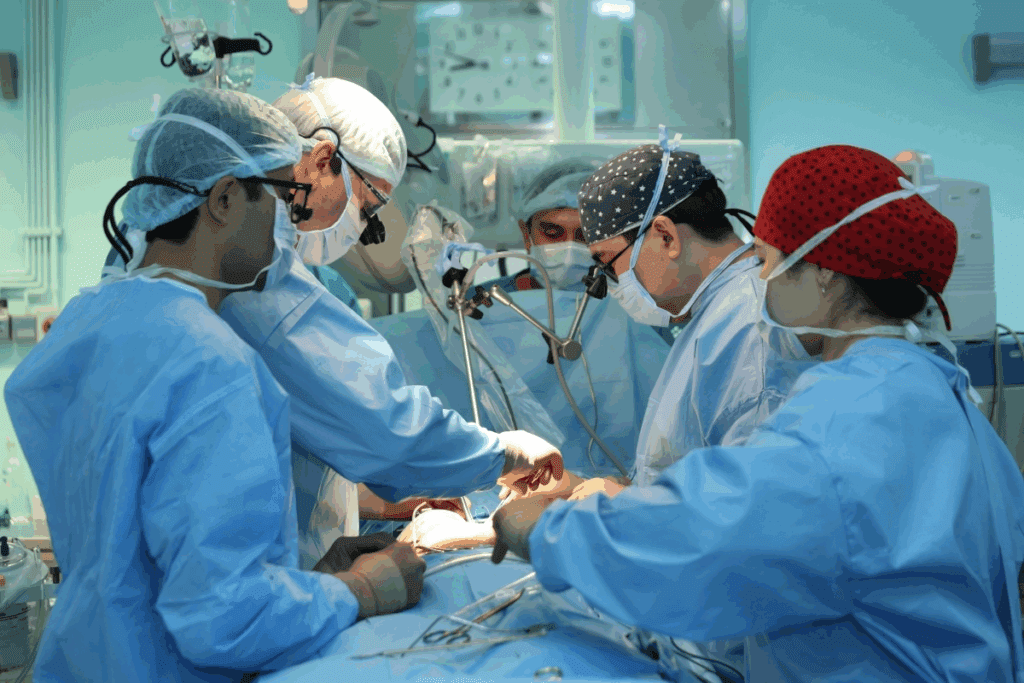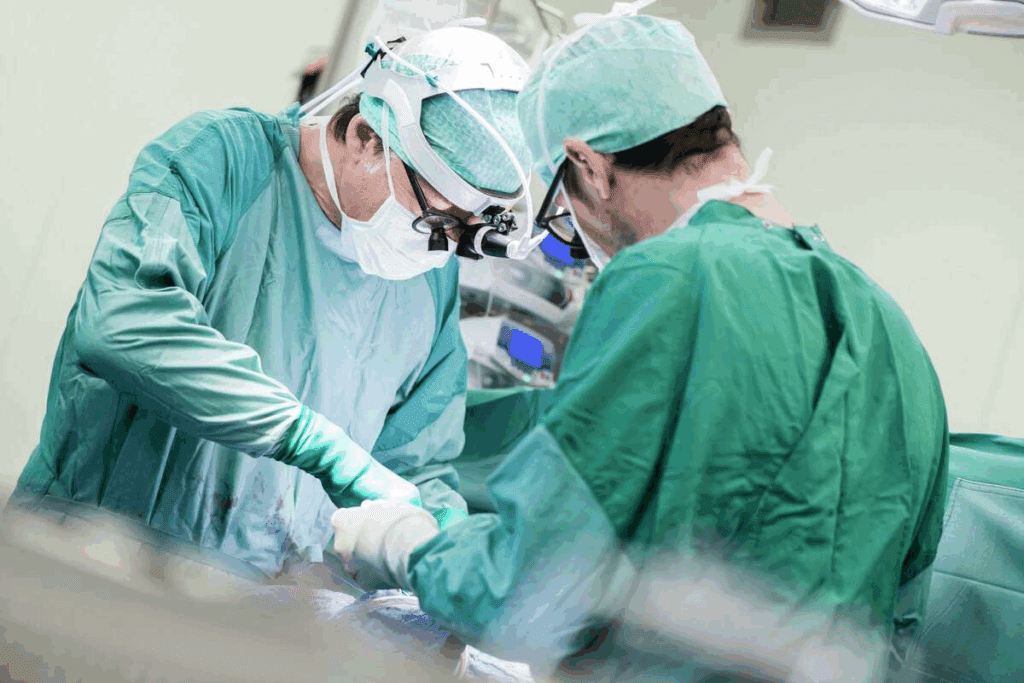Last Updated on November 26, 2025 by Bilal Hasdemir

At Liv Hospital, we focus on interventional cardiology. We offer a patient-centered approach to treat coronary artery disease. Cardiac balloon catheter angioplasty is a procedure to open blocked or narrowed arteries. It helps restore blood flow to the heart. Follow this step-by-step guide to cardiac balloon catheter angioplasty for blocked arteries.
Our skilled cardiologists use the newest technology for balloon angioplasty. Recent data shows the risk of major complications is under 1 percent. This makes it a safe and effective treatment for coronary artery disease.
We know that facing a medical procedure can be scary. That’s why we put patient care and support first. We help you through every step of the treatment.
Key Takeaways
- Cardiac balloon catheter angioplasty is a minimally invasive procedure.
- Liv Hospital’s cardiologists use the latest technology to perform the procedure.
- The risk of major complications is less than 1 percent.
- Patient-centered care is our top priority.
- We provide complete support throughout the treatment process.
Understanding Cardiac Balloon Catheter Angioplasty

Cardiac balloon catheter angioplasty is a key method for fixing blocked coronary arteries. It’s a big step forward in treating heart disease. It offers a less invasive option compared to old surgery methods.
Definition and Purpose of Balloon Angioplasty
Balloon angioplasty, or percutaneous transluminal coronary angioplasty (PTCA), opens up narrow or blocked arteries. Its main goal is to get blood flowing to the heart again. This helps ease chest pain and lowers the risk of heart attacks.
Historical Development and Current Applications
The idea of balloon angioplasty started in the late 1970s. It was a big leap in heart treatments. Over time, it’s evolved with new drug-eluting balloons and better catheters. Now, balloon angioplasty is a common treatment for heart disease, even for tough cases.
Safety Profile and Success Rates
Balloon angioplasty is safe when done by skilled doctors. It works well for most people, improving their symptoms and life quality. But, like any treatment, it can have risks like bleeding or artery damage.
Indications and Patient Selection

Balloon angioplasty is now used for more patients than before. We check each patient to see if it’s right for them.
Primary Indications for Balloon Angioplasty
It’s mainly for those with coronary artery disease (CAD). This includes people with angina or who have had a heart attack. It’s also for those with big blockages in their heart arteries.
The main reasons include:
- Stable angina with big blockages in heart arteries
- Unstable angina with high-risk signs
- Acute myocardial infarction
- Big stenosis in a coronary artery bypass graft
Contraindications and Risk Assessment
Even though it’s a good option, there are some things to think about. We look at each patient’s health, medical history, and heart disease to see the risks and benefits.
Things that might not be a good idea include:
- Severe kidney disease or kidney failure
- Bleeding disorders or taking blood thinners
- Severe peripheral artery disease
Patient Evaluation Criteria
Choosing the right patients for balloon angioplasty is key. We look at symptoms, heart anatomy, and overall health.
| Evaluation Criteria | Description |
| Clinical Presentation | Symptoms, medical history, and risk factors |
| Coronary Anatomy | Location, severity, and characteristics of coronary lesions |
| Overall Health Status | Presence of comorbidities, kidney function, and other health factors |
By looking at these things, we can pick the best treatment for each patient. This helps ensure the best results.
Pre-Procedure Patient Preparation
Before balloon angioplasty, patients need to prepare well. This preparation is key for a safe and successful heart procedure balloon intervention.
Required Laboratory Tests and Imaging
Patients usually get several tests and imaging studies before the balloon cardiology procedure. These include:
- Complete blood count (CBC) to check overall health and find any issues.
- Blood chemistry tests to see how the kidneys are working and other important things.
- Coagulation studies to check the risk of bleeding.
- Electrocardiogram (ECG) to look at heart rhythm.
- Chest X-ray to check the heart and lungs.
- Coronary angiography or balloon angiogram to see the coronary arteries and find blockages.
These tests help us understand the patient’s health and plan the balloon catheter heart procedure.
Medication Management
Managing medications is a big part of getting ready for the procedure. Patients might need to:
- Keep taking some medications as their doctor tells them.
- Stop blood thinners or antiplatelet drugs for a while before the procedure, with doctor’s advice.
- Change the dose of some medications, like for diabetes or high blood pressure.
It’s very important for patients to follow their doctor’s advice on medications. This helps reduce risks during the heart procedure balloon intervention.
Patient Education and Informed Consent
Teaching patients about their balloon cardiology procedure is very important. This includes:
- Explaining the procedure, its benefits, and possible risks.
- Talking about other treatment options.
- Getting informed consent, making sure patients know what they’re agreeing to.
By educating patients and getting their informed consent, we help them make good choices. This leads to better results for balloon catheter heart procedures.
Cardiac Balloon Catheter Types and Selection
Cardiac balloon catheters come in many designs and sizes. Each is made for different patient needs and lesion types. This variety helps treat coronary artery disease more effectively.
Balloon Catheter Designs and Sizes
Balloon catheters are made from different materials and shapes. Compliant balloons stretch and expand at a certain pressure. They offer some flexibility in sizing.
Non-compliant balloons keep their size and shape, even at high pressures. This gives more precise results in angioplasty.
Their sizes range from 1.5 mm to 4.0 mm in diameter, and 8 mm to 30 mm in length. The right size depends on the lesion’s size and the vessel’s anatomy.
Specialized Angioplasty Balloons
There are special angioplasty balloons for different situations:
- Cutting Balloons: These have microsurgical blades for tough or complex lesions.
- Scoring Balloons: They have a nitinol scoring element for precise dilation.
- Drug-Coated Balloons: These release anti-restenotic drugs into the vessel wall. This reduces restenosis risk.
Matching Balloon Specifications to Lesion Characteristics
Choosing the right balloon catheter needs a good look at the lesion. This includes its length, diameter, and calcification level. Lesion assessment is key to picking the correct size and type.
| Lesion Characteristic | Balloon Specification |
| Short Lesions | Shorter balloons (8-12 mm) |
| Long Lesions | Longer balloons (20-30 mm) |
| Calcified Lesions | Non-compliant or specialized balloons |
Matching the balloon catheter to the lesion’s characteristics improves angioplasty success. It also reduces complications.
Equipment and Catheterization Laboratory Setup
Balloon angioplasty needs a well-equipped catheterization laboratory for safe and effective treatment. The cath lab is a special part of hospitals. Here, cardiologists do procedures like balloon angioplasty without big surgery.
Essential Equipment for Angioplasty
The cath lab has all the needed tools for balloon catheter angioplasty. This includes the angioplasty balloon catheter, guidewires, sheaths, and more. The angioplasty balloon catheter is key. It helps open up blocked or narrowed coronary arteries.
Guidewires are thin, flexible wires. They help guide the catheter through blood vessels to the right spot. Sheaths make it easier to put catheters and other devices into the blood system.
Guidewires, Sheaths, and Accessory Devices
Guidewires come in different sizes and shapes. They fit different patients and blockages. Sheaths vary in size and material. They work with many catheters and devices.
Accessory devices, like inflation tools and pressure monitors, control the heart catheter balloon. They make sure the balloon is inflated right. This helps open the artery without harming it.
Imaging Systems and Contrast Media
Advanced imaging systems are key in the cath lab. They show the coronary arteries in real-time during the procedure. Fluoroscopy and digital subtraction angiography are common. They help guide the balloon in heart procedures.
Contrast media make the arteries and blood vessels clearer. The right contrast media depends on the patient’s allergies and kidney function.
Vascular Access Techniques
Balloon angioplasty needs precise vascular access. There are different ways to do this. The right access site is key for success.
Femoral Approach: Technique and Considerations
The femoral approach is a common method. It uses the femoral artery in the groin. Pre-procedure ultrasound helps find the artery and check if it’s good for access.
Things to think about with the femoral approach include:
- Patient anatomy and artery size
- Presence of peripheral artery disease
- Potential for bleeding complications
Radial Approach: Technique and Benefits
The radial approach uses the wrist’s radial artery. It’s popular because it might reduce bleeding risk and let patients move sooner. It needs special skills and tools.
Benefits of the radial approach include:
- Lower risk of access site complications
- Improved patient comfort and earlier discharge
- Reduced risk of bleeding
Access Site Management and Complications
Managing the access site well is important to avoid problems. This includes using the right closure methods and watching the patient after the procedure.
| Complication | Prevention Strategy | Management |
| Bleeding | Proper closure, anticoagulation monitoring | Manual compression, transfusion if necessary |
| Hematoma | Careful access technique, ultrasound guidance | Observation, possible drainage |
| Arteriovenous Fistula | Precise needle placement, avoiding venous puncture | Monitoring, possible embolization |
Knowing about vascular access techniques helps cardiologists improve balloon angioplasty results.
Performing the Balloon Angiogram and Lesion Assessment
The first step in balloon angioplasty is a detailed look at the coronary arteries. This is done through diagnostic angiography. It’s key to know how bad the disease is.
Diagnostic Angiography Techniques
Diagnostic angiography uses contrast media and X-ray imaging. It helps us see the coronary arteries clearly. We use different methods to get a good view of the lesions.
Some important techniques include:
- Choosing the right catheters for the job
- Using many angles to study the lesions
- Ensuring the contrast media works well
Interpreting Coronary Angiograms
Understanding coronary angiograms is essential. We look for signs of blockages and other problems. This helps us decide how to treat the patient.
“Accurate interpretation of coronary angiograms is key to choosing the right treatment.”
Interventional Cardiologist
Lesion Characterization and Measurement
Knowing the details of the lesions is vital. We measure their length, diameter, and how complex they are. This helps us pick the right balloon size and type.
| Lesion Characteristic | Description | Importance in Balloon Angioplasty |
| Lesion Length | How long the blockage is | Tells us how long the balloon needs to be |
| Lesion Diameter | The size of the blockage | Helps choose the balloon size |
| Lesion Complexity | Includes things like calcification and twists | Helps pick the balloon and how to do the procedure |
Determining Intervention Strategy
After looking at the lesion, we decide the best course of action. This means picking the right balloon catheter and planning the steps of the procedure.
By carefully looking at the angiogram and understanding the lesion, we can make our treatment plan better. This helps us get the best results for our patients.
Step-by-Step Balloon Catheterization Technique
To get the best results from cardiac balloon catheter procedures, we follow a step-by-step method. We’ll walk you through each critical stage of balloon catheterization. This ensures every step is done with great care and precision.
Guidewire Placement and Navigation
The first step is placing the guidewire. We carefully move the guidewire through the blood vessels to the target area. This step needs precise control and real-time imaging for accurate placement.
- Select a guidewire that fits the lesion’s characteristics.
- Advance the guidewire under fluoroscopic guidance.
- Watch for any resistance or complications.
Balloon Catheter Preparation and Testing
After the guidewire is in place, we prepare the balloon catheter. We check the balloon’s integrity and make sure it fits the lesion’s size.
- Inspect the balloon catheter for any defects.
- Test the balloon by inflating it with a recommended pressure.
- Make sure the balloon catheter is securely attached to the guidewire.
Crossing and Positioning at the Lesion
Now, we move to cross the lesion with the balloon catheter. This step requires gentle manipulation and careful observation to avoid problems.
- Advance the balloon catheter over the guidewire to the lesion site.
- Position the balloon catheter so the balloon is centered across the lesion.
- Use angiographic imaging to confirm the position.
Balloon Inflation Techniques and Pressure Management
The last step is inflating the balloon to the right pressure. We manage the pressure carefully to achieve optimal dilation and avoid complications.
- Inflate the balloon gradually to the recommended pressure.
- Watch the inflation process for any signs of complications.
- Keep the inflation going for the needed time before deflating.
Managing Complications During Heart Balloon Procedure
The cardiac balloon procedure is a complex intervention. It requires careful management of possible complications. We must be aware of the complications that can arise and have strategies to manage them effectively.
Common Procedural Complications
During a heart balloon procedure, several complications can occur. These include acute closure, perforation, and hemodynamic instability. Acute closure is when the artery suddenly blocks after angioplasty. This can lead to severe consequences if not addressed quickly. Perforation is when the arterial wall gets punctured or torn. This can cause cardiac tamponade or other serious complications.
Hemodynamic instability can also happen during or after the procedure. It’s when blood pressure and cardiac output change. Managing these complications requires a deep understanding of the procedure and the patient’s condition.
| Complication | Description | Management Strategy |
| Acute Closure | Sudden blockage of the artery | Emergency interventions, including repeat balloon inflation or stenting |
| Perforation | Puncture or tear of the arterial wall | Immediate recognition and treatment with covered stents or surgery |
| Hemodynamic Instability | Fluctuations in blood pressure and cardiac output | Close monitoring and adjustment of medications or fluid status |
Emergency Interventions for Acute Closure
In case of acute closure during balloon angioplasty, quick action is needed. We might repeat balloon inflation to open the artery or use a stent to keep it open. The choice depends on the situation and the patient’s health.
Perforation Management
Managing perforation requires quick recognition and treatment. We might use covered stents to seal the perforation. Sometimes, surgery is needed. The goal is to act fast to prevent more problems.
Hemodynamic Instability Protocols
Hemodynamic instability during or after balloon angioplasty needs close monitoring. We adjust medications, manage fluids, or use other measures to stabilize the patient. This helps keep the patient safe and stable.
Understanding and managing these complications makes the heart balloon procedure safer and more successful.
Post-Procedure Care and Follow-Up
After a cardiac balloon catheter angioplasty, it’s key to follow care steps to avoid problems and help healing. We’ll walk you through what you need to do to recover well.
Immediate Post-Procedure Monitoring
Right after the balloon angioplasty procedure, you’ll be watched closely in a recovery area for hours. This watch is important to catch any early signs of trouble like bleeding or heart issues. Our team checks your heart rate, blood pressure, and oxygen levels to keep you stable.
Access Site Care and Ambulation
Looking after the spot where the catheter was inserted is very important. We’ll teach you how to keep it clean and dry and watch for any signs of infection or bleeding. We also tell you to move slowly to avoid blood clots and help your blood flow. It’s very important to follow these steps to avoid problems.
Medication Management
Medicine is a big part of your care after the procedure. You’ll likely take medicine to stop clots from forming. We stress the importance of taking your medicine as directed and talk about possible side effects. It’s important to know why you’re taking each medicine and to tell us about any side effects right away.
Discharge Instructions and Follow-Up Schedule
Before you go home, we’ll give you a lot of information on how to care for yourself, including wound care and activity levels. We also set up follow-up visits to check on your healing and see how the cardiac balloon catheter procedure is working. These visits are important to answer any questions and make any needed changes to your care plan.
To sum up, important parts of post-procedure care include:
- Watching for complications right away
- Proper care of the access site
- Following your medicine schedule
- Following the instructions we give you
- Going to your follow-up appointments
By following these steps, you can help make your recovery after a heart procedure balloon angioplasty go smoothly. Our team is here to support and guide you every step of the way.
Conclusion
Cardiac balloon catheter angioplasty is a key treatment for coronary artery disease. It’s a minimally invasive way to improve blood flow to the heart. At Liv Hospital, we’ve created a detailed guide on balloon angioplasty.
This guide covers everything from choosing the right patients to caring for them after the procedure. It shows how important skilled interventional cardiology is.
Our guide explains the cardiac balloon catheter process in detail. It talks about picking the right angioplasty balloon catheter, how to access the blood vessels, and handling any problems that might come up. Knowing how heart catheter balloon procedures work helps doctors give the best care to patients having balloon angioplasty.
At Liv Hospital, we’re all about top-notch care in interventional cardiology. We make sure our patients get the best results. Our team is always learning about new medical breakthroughs. We offer personalized care and support every step of the way.
FAQ
What is cardiac balloon catheter angioplasty?
Cardiac balloon catheter angioplasty, also known as balloon angioplasty, is a procedure to widen narrowed arteries. It uses a balloon catheter to improve blood flow to the heart.
What is the purpose of balloon angioplasty?
The main goal of balloon angioplasty is to treat coronary artery disease. It opens blocked or narrowed arteries. This improves blood flow to the heart and reduces symptoms like chest pain.
How is a cardiac balloon catheter selected for angioplasty?
We choose a cardiac balloon catheter based on the size and type of the blockage. The balloon’s size, length, and type are selected to fit the patient’s needs and the blockage.
What are the risks associated with balloon angioplasty?
Balloon angioplasty is generally safe but carries risks. These include bleeding, infection, damage to the blood vessel, and the artery becoming blocked again. We take steps to minimize these risks.
How is vascular access achieved for balloon angioplasty?
Vascular access can be through the femoral or radial approach. We choose the best approach based on the patient’s condition and the procedure’s specifics.
What is the role of diagnostic angiography in balloon angioplasty?
Diagnostic angiography helps us see the coronary arteries and find blockages. We use the angiogram to plan the best treatment and the angioplasty procedure.
How is the balloon catheter positioned during angioplasty?
We use a guidewire to guide the balloon catheter to the blockage. The balloon is then inflated to widen the artery.
What happens after the balloon angioplasty procedure?
After the procedure, we closely monitor the patient for complications. We provide instructions on post-procedure care, including medication and follow-up appointments.
What is the success rate of balloon angioplasty?
Balloon angioplasty is very effective in improving blood flow and reducing symptoms. Success rates vary based on the disease’s severity and the patient’s health.
Can balloon angioplasty be repeated if necessary?
Yes, balloon angioplasty can be repeated if needed. We decide based on the patient’s condition and follow-up evaluations.
How does Liv Hospital support patients undergoing balloon angioplasty?
At Liv Hospital, we offer full care and support from the start to after the procedure. We ensure our patients get the best outcomes.
Reference
- National Heart, Lung, and Blood Institute. (2023). Getting a stent. https://www.nhlbi.nih.gov/health/stents/during






